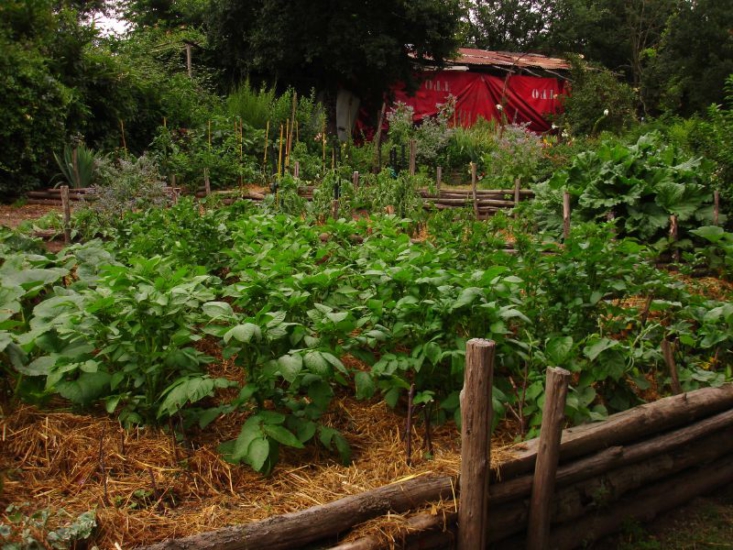Greatest Hits 2021: This week, we’ll be republishing the most popular posts of the year. Happy reading!
Perhaps, like me, you grow herbs and vegetables in traditional garden beds made from lumber, nails, and bolts, and filled with organic soil and compost. There’s another way to build garden beds, though, that has been around for hundreds of years and is way more sustainable.
Hugelkulture, pronounced HEW-gul-kul-TOOr, is German for “hill mound” or “hill culture.” It’s a no-dig, drought-tolerant, raised-bed technique that relies on decomposing wood and garden debris to create what is essentially a compost pile-cum-garden bed. Now that I know about this resourceful method, I’ll never be able to look at my pedestrian garden beds the same way again.
To learn more about hugelkultur, please keep reading:
What are the benefits of hugelkultur?

Hugelkultur was coined by German horticulturists in the late 1970s but is a technique that quite possible has been around for centuries. At its most basic, hugelkultur simply means creating a layered raised garden bed from natural materials you already have. Instead of disposing all your excess logs, fallen branches and leaves, and grass clippings as garden waste, you use them to build a mound that will, within months, turn into rich garden soil for your plantings.
This type of permaculture-based planting bed has numerous positives. One is that hugelkultur beds hold on to moisture longer as the logs and branches act like living sponges that store rainwater. In fact, your hugelkultur bed can be quite drought-tolerant after the first year and may not require watering at all.

Your hugel bed also builds up fertile soil, increases soil aeration, generates heat which extends the growing season, and uses the natural and gradual decay of wood and garden debris to boost plant growth with its slow release of important nutrients; this means fertilizing is not needed. In addition, hugelkultur encourages an environment teeming with beneficial worms, fungi and mycorrhizae. Last, by not burning your excess wood (which adds carbon to the air), you are locking carbon into the soil instead.
How do you build a huglekultur bed?

Like composting, the key to hugelkultur is its mix of brown and green materials. Here are the basics: first pile up cut logs, old firewood, or thick branches as your woody base layer. If you have to, you can always call your local power company and ask them to drop off free wood. Next, cover the woody base with about 12 inches of dead leaves and dry straw. You can also add other items like cardboard and newspaper into the middle layers.

Then layer on some green leaves and lawn clippings and top with organic well-rotted compost. Finally your organic cake receives an icing of topsoil. Once built up, your raised bed is ready to be planted. Excellent edibles to grow are potatoes, sweet potatoes, pumpkins, tomatoes, lettuce, and berry bushes.
Any tips for a successful hugelkultur?

- The best time to build a hugel bed is in the fall so that all the pieces and parts can settle in and start breaking down, all ready for a spring planting.
- Some gardeners like to build the beds tall which gives you more surface to plant in and better access when harvesting. Also, the more mass you create the more water retention.
- Most wood is suitable for the base of your hill mound, like willow, apple, birch, maple, and oak. Some sources say to avoid wood that is naturally rot-resistant like black locust, black cherry and cedar. The one wood to definitely avoid is black walnut as it contains natural chemicals that prevent plants from properly growing.
- Site your bed in an area that matches what you want to grow. If you want sun loving vegetables, then build your bed in a sunny spot, But if you only have shade, then build it there and grow shade-tolerant plants.
- If creating your hugel mound over an existing lawn, first mow the area down then smother the grass with cardboard before laying the log base.
For similar no-dig methods, see:
- The Garden Decoder: What Is ‘Lasagna Gardening’?
- Charles Dowding’s No-Dig (And No Weed) Garden in Somerset
For more organic ways to boost your soil, see:
- The Garden Decoder: What Is ‘Biochar’?
- Gardening 101: How to Use Eggshells in the Garden
- Dirty Secrets: 9 Ways to Improve Garden Soil
N.B.: This post was first published March 2021.












Have a Question or Comment About This Post?
Join the conversation (3)